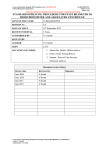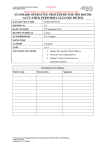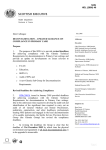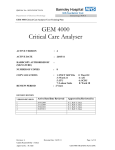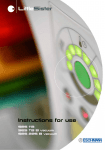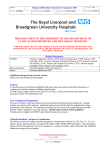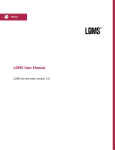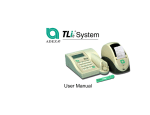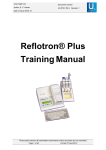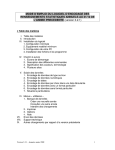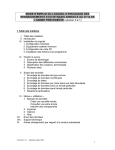Download Document title: fill in the title of your SOP
Transcript
Luton and Dunstable Hospital NHS Foundation Trust CONTROLLED Clinical Biochemistry LI-BIO-POCTFFNUs Edition Number 1.0 Page 1 of 17 PRINTED COPIES UNCONTROLLED UNLESS MARKED “CONTROLLED” IN RED STANDARD OPERATING PROCEDURE FOR FETAL FIBRONECTIN USING THE RAPID Ffn® 10Q SYSTEM Q-PULSE FILE NAME LI-BIO-POCFFNUs EDITION No 1.0 DATE OF ISSUE 19th April 2013 REVIEW INTERVAL 2 Years AUTHORISED BY N Vaughan SIGNATURE AUTHOR N Vaughan COPY 1 of 3 LOCATION OF COPIES 1. Master file, Quality Officer Shelves 2. Point of Care Testing Shelves 3. Intranet / Point of Care Services Electronic archives Document review history Review date Reviewed by Signature C:\Documents and Settings\nasmith\Local Settings\Temp\LI-BIO-POCTFFNUs_4FEBCCEC.doc Author N A Vaughan Authorised by N A Vaughan Luton and Dunstable Hospital NHS Foundation Trust CONTROLLED Clinical Biochemistry LI-BIO-POCTFFNUs Edition Number 1.0 Page 2 of 17 PRINTED COPIES UNCONTROLLED UNLESS MARKED “CONTROLLED” IN RED DOCUMENT AMENDMENT FORM FOR STANDARD OPERATING PROCEDURE FOR FETAL FIBRONECTIN USING THE RAPID Ffn® 10Q SYSTEM Record Filename LP-BIO-POCFFN Number Date Page Amendment Number Authorised by 1 2 3 4 5 6 7 8 9 10 The amendment must be authorised by the POCT Manager to ensure all copies including the electronic version are updated simultaneously. Any minor amendment must be handwritten without obscuring the previous text. An asterisk is written in the adjacent margin to highlight the alteration and is signed and dated by the POCT Manager. Amendments requiring immediate action must be handwritten without obscuring the previous text. An asterisk is written in the adjacent margin to highlight the alteration and is signed and dated by the POCT Manager. Ten or less minor amendments may be recorded before a new edition is issued. Major changes must result in the immediate review of the procedure. Document amendment does not replace the review process. C:\Documents and Settings\nasmith\Local Settings\Temp\LI-BIO-POCTFFNUs_4FEBCCEC.doc Author N A Vaughan Authorised by N A Vaughan Luton and Dunstable Hospital NHS Foundation Trust CONTROLLED Clinical Biochemistry LI-BIO-POCTFFNUs Edition Number 1.0 Page 3 of 17 PRINTED COPIES UNCONTROLLED UNLESS MARKED “CONTROLLED” IN RED HAZARDS AND PRECAUTIONS For appropriate use of protective clothing, please refer to ‘LDH Infection Control Manual’. Substance Hazards Cervicovaginal secretions Danger of infection Extraction Buffer IQC May cause skin and eye irritation Danger of infection. May cause skin and eye irritation EQA Danger of infection PDI Sanicloth 70 Irritating to eyes (R36) Highly flammable (R11) Precaution Follow standard precautions. See above. Dispose of in orange clinical waste bags. Avoid contact with skin and eyes Follow standard precautions. See above. Dispose of in orange clinical waste bags. Avoid contact with skin and eyes. Follow standard precautions. See above. Dispose of in orange clinical waste bags. Keep away from sources of ignition. No smoking First aid Code* A1, B, C, D A1, B, C, D A1, B, C, D A1, B, C, D A, B, C IF IN ANY DOUBT CONSULT A SENIOR MEMBER OF STAFF OR YOUR SAFETY REPRESENTATIVE *Key: A1 Ingestion: wash mouth thoroughly with water and give plenty to drink. In severe cases obtain medical attention. B Eye contact: irrigate thoroughly with water. Seek medical help. C Skin contact: wash off skin thoroughly with water. D Inhalation: remove to fresh air. If severe call a physician. If First Aid treatment has to be given contact the nearest first aider but do not delay treatment to the casualty. If necessary, call the crash team 2222. Treat all body tissue and waste as potential infective. In all cases, an Incident form must be filled in and report to Occupational Health or Accident Service if out of hours. See Also Risk Assessments: Blood or Body Fluid Analysis 47 C:\Documents and Settings\nasmith\Local Settings\Temp\LI-BIO-POCTFFNUs_4FEBCCEC.doc Author N A Vaughan Authorised by N A Vaughan Luton and Dunstable Hospital NHS Foundation Trust CONTROLLED Clinical Biochemistry LI-BIO-POCTFFNUs Edition Number 1.0 Page 4 of 17 PRINTED COPIES UNCONTROLLED UNLESS MARKED “CONTROLLED” IN RED TABLE OF CONTENTS 0 INTRODUCTION................................................................................................................... 5 0.1 Purpose and Scope ........................................................................................................... 5 0.2 Clinical Indication ............................................................................................................ 5 0.3 Responsibilities ................................................................................................................ 5 0.4 References ........................................................................................................................ 6 0.5 Definitions........................................................................................................................ 6 0.6 Documentation ................................................................................................................. 7 1 PRE-EXAMINATION PROCESS ......................................................................................... 7 1.1 Patient Preparation ........................................................................................................... 7 1.2 The Specimen ................................................................................................................... 7 1.4 Spillage of Clinical and Non-Clinical Waste ................................................................... 7 1.5 Retention of Clinical Material and Records ..................................................................... 8 1.6 Disposal of Clinical and Non-Clinical Waste .................................................................. 8 2 EXAMINATION PROCESS .................................................................................................. 8 2.0 Analytical Principle.......................................................................................................... 8 2.1 Limitations of Analytical Procedure ................................................................................ 8 2.1.1 The device ................................................................................................................. 8 2.1.2 Cross-reactivity ......................................................................................................... 8 2.1.3 Interferences .............................................................................................................. 8 2.1.4 Specimens unsuitable for analysis............................................................................. 9 2.1.5 Safety Notices ........................................................................................................... 9 2.2 Central Database and Connectivity .................................................................................. 9 2.3 Equipment ........................................................................................................................ 9 2.5 Calibration........................................................................................................................ 9 2.6 Quality Assurance Programme....................................................................................... 10 2.6.1 Daily QC (QCette Quality Control Device) ............................................................ 10 2.6.2 Liquid Internal Quality Control............................................................................... 10 2.6.3 External Quality Assessment .................................................................................. 11 2.6.4 Internal Controls...................................................................................................... 11 2.7 The Test Procedure......................................................................................................... 11 2.8 Results ............................................................................................................................ 12 2.9 Maintenance ................................................................................................................... 12 2.9.1 As required .............................................................................................................. 12 2.9.2 Weekly .................................................................................................................... 12 2.9.3 Changing the printer labels ..................................................................................... 12 2.10 Troubleshooting ........................................................................................................... 13 3 POST-EXAMINATION PROCESS ..................................................................................... 13 3.1 Reference Values............................................................................................................ 13 3.2 Reporting the Results ..................................................................................................... 13 3.4 Reviewing Previous Results........................................................................................... 14 3.5 Performance Criteria (uncertainty!!) .............................................................................. 14 3.6 Documentation ............................................................................................................... 14 3.7 Audit of Results and Indication...................................................................................... 15 3.8 Comparability................................................................................................................. 15 4 SELF ASSESSMENT COMPETENCY FORM................................................................... 16 C:\Documents and Settings\nasmith\Local Settings\Temp\LI-BIO-POCTFFNUs_4FEBCCEC.doc Author N A Vaughan Authorised by N A Vaughan Luton and Dunstable Hospital NHS Foundation Trust CONTROLLED Clinical Biochemistry LI-BIO-POCTFFNUs Edition Number 1.0 Page 5 of 17 PRINTED COPIES UNCONTROLLED UNLESS MARKED “CONTROLLED” IN RED 0 INTRODUCTION 0.1 Purpose and Scope This document describes the procedure for measuring fetal fibronectin using the Rapid fFN 10Q system in delivery suite to ensure the provision of accurate and reliable patient results for the Clinician to act upon. The system measures fetal fibronectin in cervicovaginal secretions which is associated with increased risk of preterm delivery in symptomatic pregnant women between 24 weeks and 34 weeks 6 days gestation. 0.2 Clinical Indication The test is used as an aid in assessing the risk of preterm delivery in the next 7-14 days in pregnant women with signs and symptoms of early preterm labour, intact amniotic membranes and minimal cervical dilatation (<3cm). It can only be used in women who are between 24 weeks and 34 weeks 6 days gestation. Signs and symptoms of preterm labour include uterine contractions, change of vaginal discharge, vaginal bleeding, backache, abdominal discomfort, pelvic pressure and cramping. Fetal fibronectin is a major component of the extracellular matrix of the amniotic sac membranes. Fetal fibronectin can be detected in cervicovaginal secretions of women in the first 24 weeks of pregnancy, but diminishes between 24 and 34 weeks in normal pregnancies. Its detection between 24 and 34 weeks gestation is associated with preterm delivery. Testing for fetal fibronectin should reduce unnecessary admissions, use of steroids and tocolytics among women with negative test results. 0.3 Responsibilities POCT Management group ensure: The responsibilities, authority and interrelationships of all personnel involved in POCT are specified and communicated within the organisation; Staff performing POCT receive appropriate training, supervision and competence testing; The selection of POCT devices and systems includes their practicability and the comparability of their results with those obtained in the laboratory; The reports of the POCT quality assurance programme(s) are reviewed by the group and advice on improvement is provided and implemented. Senior Clinical Biochemistry Management Staff ensure: Departmental policies and procedures are in accord with the requirements of the MHRA bulletins, Trust Medical Device Management Policy and Pathology Accreditation [CPA(UK)Ltd] standards and any other quality standards to which the organisation subscribes; The needs and requirements of the users are reviewed regularly; Persistent problems are escalated to the relevant manufacturer and actioned; Determining and documenting back up plans if equipment is out of action, however please note that there is no back up service for measurement of fibronectin; Clinical Biochemistry Staff with POCT responsibilities ensure: Regular tasks in the management of the POCT service are carried out; Persistent problems are notified to senior departmental staff; Clinical Biochemistry Staff on-call: On-call staff should not leave the laboratory to trouble-shoot POCT as this compromises the on-call service, there is no back up laboratory service for measurement of fibronectin; Users ensure: Their annual training is kept up to date and they are competent to practice; C:\Documents and Settings\nasmith\Local Settings\Temp\LI-BIO-POCTFFNUs_4FEBCCEC.doc Author N A Vaughan Authorised by N A Vaughan Luton and Dunstable Hospital NHS Foundation Trust CONTROLLED Clinical Biochemistry LI-BIO-POCTFFNUs Edition Number 1.0 Page 6 of 17 PRINTED COPIES UNCONTROLLED UNLESS MARKED “CONTROLLED” IN RED The correct specimen is obtained from the correct patient under the correct circumstances and the correct specimen is tested; The specimen is collected with minimal discomfort to the patient; The test is carried out according to the manufacturer’s instructions; The test is correctly recorded in the device or record book and in the patient’s notes; The specimen is disposed of according to the Trust Waste Management Policy; Clinical biochemistry POCT staff are informed in the event of problems with the device; If issued with a log-on code or barcode this is kept secure and used only be themselves. Sharing or photocopying barcodes/log-on details is a disciplinary offence according to Trust Information Technology Security policy; The results are reported as appropriate. Ward/department Manager ensures: Users of the equipment keep their training up to date and maintain their competency. Adequate supplies of consumables are maintained; Appropriate resources are available; Proper records of training and competency are maintained; Ensures that faulty equipment is taken out of use; Notifies the POCT team if equipment is obsolete or no longer required; Infection Control Nurse Safety representative / ensures: Performs a risk assessment for handling biological material; Advises on precautions to be taken when handling biological material including spillages, and safe disposal. Advises on safety of products before purchase; Updates COSHH details and advises on precautions to be taken when handling all material including spillage, breakage and disposal. Manufacturers ensure: The user is kept up to date with information regarding the device and the associated products that they provide; Provide training sessions for the user in order to provide competent use of the instrument; Provide regular audits of the equipment; Fulfil the criteria agreed in the purchasing contract or tender. 0.4 References Management of In Vitro Diagnostic Medical Devices, MDA Bulletin DB2002 (02) PD-GEN-MDAIVDMg Management and Use of Point of Care Devices, MDA Bulletin DB2010 (02) PDGEN-MDAPOCTMg LDH Point of Care Testing Policy MP-GEN-LDHPOCTPo LDH Infection Control Policy MI-GEN-LDHInfCrl LDH Health and Safety Policy MP-GEN-LDHH&SPol LDH Waste Management Policy MP-GEN-LDHWsMgP LDH Information Technology Security Policy MP-GEN-LDHIM&TPO 0.5 Definitions User - Any person who handles the device whether it is used directly to produce results or indirectly for maintenance and Quality Assurance Procedures. This includes Clinicians, Nursing Staff, Healthcare Scientists and Medical Equipment Technicians as necessary. EQAS – External Quality Assessment Scheme C:\Documents and Settings\nasmith\Local Settings\Temp\LI-BIO-POCTFFNUs_4FEBCCEC.doc Author N A Vaughan Authorised by N A Vaughan Luton and Dunstable Hospital NHS Foundation Trust CONTROLLED Clinical Biochemistry LI-BIO-POCTFFNUs Edition Number 1.0 Page 7 of 17 PRINTED COPIES UNCONTROLLED UNLESS MARKED “CONTROLLED” IN RED POCT – Point of Care Testing SOP – Standard Operating Procedure IQC – Internal Quality Control MHRA – Medicines and Healthcare Products Regulatory Agency 0.6 Related Documents In House Health and Safety Policy MP-GEN-H&SMan Spillage, Decontamination and Waste Disposal Procedures MI-GEN-SplDcnWst LDH Use of Fetal Fibronectin Test for Preterm Labour (CG321) Rapid fFN®10Q System Quick Reference Guide Fetal Fibronectin Record Book 1 PRE-EXAMINATION PROCESS 1.0 Training & Competency Fetal fibronectin testing should only be carried out by trained and competent users. Training is the responsibility of the POCT team (Ext 7991) in conjunction with the manufacturers. Self-competency assessment forms are available as an Appendix to this document. Records of those attending training sessions and completed competency documents are kept by the POCT team. 1.1 Patient Preparation Cervical disruption due to such events as sexual intercourse, digital cervical examination or vaginal probe ultrasound may cause a positive fetal fibronectin result. Therefore do not perform the test until 24 hours after any of these events have occurred. If you are unsure whether the test is required, or whether cervical disruption has occurred, then collect the specimen and subsequently carry out an examination. If any cervical disruption has occurred a repeat test must wait for 24 hours after this has taken place this should be determined in consultation with the patient and clinician. Please note if the patient reports having had intercourse in the previous 24 hours, a negative test result is valid. Patients with known or suspected placental abruption, placenta previa or moderate or gross vaginal bleeding should not be tested for fetal fibronectin. Ruptured membranes, cervical dilatation >3cm or cervical cerclage are also contraindications for the test. The sample is collected from the cervicovaginal secretions during speculum examination. The patient should therefore be prepared appropriately and a speculum inserted into the vagina. 1.2 The Specimen The specimen should be obtained from the posterior fornix of the vagina during a speculum examination. The polyester-tipped applicator provided in the Rapid fFN Specimen collection kit should be inserted into the vagina and lightly rotated across the posterior fornix for approximately 10 seconds to absorb the cervicovaginal secretions. Please note no lubricants, soaps or creams etc can be used in collecting this specimen as they will prevent absorption of fibronectin onto the applicator, water may be used if required. Once the specimen is obtained, carefully remove the applicator from the vagina and immerse the tip in the tube of buffer provided in the collection kit. Break the shaft at the scored area; this should be almost level with the top of the tube. Align the shaft with the hole inside the tube cap and push down lightly over the shaft sealing the tube. Label the tube with the patient’s details. The patient’s first name, surname and hospital number must be included along with date and time of collection. Specimens will normally be tested straight away, but are stable for 8 hours at room temperature. 1.4 Spillage of Clinical and Non-Clinical Waste Spillage of Clinical and Non-clinical waste must be dealt with according to the Trust Health and Safety policy. C:\Documents and Settings\nasmith\Local Settings\Temp\LI-BIO-POCTFFNUs_4FEBCCEC.doc Author N A Vaughan Authorised by N A Vaughan Luton and Dunstable Hospital NHS Foundation Trust CONTROLLED Clinical Biochemistry LI-BIO-POCTFFNUs Edition Number 1.0 Page 8 of 17 PRINTED COPIES UNCONTROLLED UNLESS MARKED “CONTROLLED” IN RED 1.5 Retention of Clinical Material and Records The patient’s results must be immediately transcribed into their notes and recorded in the record book for the analyser. When the record book is full they should be kept in a secure place on Delivery Suite for the lifetime of the analyser (or, if required by other guidelines, for the longest time period necessary). 1.6 Disposal of Clinical and Non-Clinical Waste Clinical and Non-clinical waste must be disposed of according to the Trust Health and Safety policy. Used test kits and sample collection kits must be disposed of in clinical waste. 2 EXAMINATION PROCESS 2.0 Analytical Principle The test is an immunoassay for the detection of fetal fibronectin in cervicovaginal secretions. It utilizes a combination of monoclonal and polyclonal antibody reagents to selectively detect fetal fibronectin. The specimen is collected and then immersed into a buffer solution. 0.2mL from a syringe of this solution is then dispensed onto the sample application well of the cassette. The sample flows from an absorbent pad across a membrane by capillary action and interacts with the reagent antibodies, some of which have coloured dye attached. The analyser detects the formation of coloured lines in the result area of the cassette. Specimens containing fetal fibronectin react with the specific antibody-fibronectin-coloured conjugate and form a coloured line in one portion of the cassette membrane. Absence of this coloured line suggests a negative result. To serve as a positive procedural control, a second coloured control line will always appear on the cassette membrane regardless of the presence or absence of fibronectin. If the second line does not appear here the test is invalid. The Rapid fFN 10Q analyser interprets the intensities of the test and control lines at the end of the 7 minute reaction time and produces the results. 2.1 Limitations of Analytical Procedure Refer to Section 1.1 Patient Preparation Under no circumstances should glass tubes or pipettes be used in association with fetal fibronectin as fetal fibronectin binds to glass. Polypropylene or polyethylene are acceptable. Under no circumstances can results be read visually. Do not mix materials from different kit lots or use devices beyond their expiry dates. Only samples collected from the posterior fornix are suitable. 2.1.1 The device The Cassette: must be stored at room temperature between 15-30oC. Handle cassettes with care, do not touch, scratch or compress membrane materials in the cassette. The Analyser & Printer: must be operated at room temperature 15-30oC and between 20-80% non condensing humidity. The QCette: should be stored at room temperature 15-30 oC and also stored in the container provided as it must be kept clean and dust & moisture free. 2.1.2 Cross-reactivity There are no known cross-reacting interferences. 2.1.3 Interferences Assay interference from the following components has NOT been excluded: Semen Lubricants, soaps, disinfectants or creams as these may interfere with the absorption of the specimen onto the applicator or the antibody reactions. Douches White and red blood cells C:\Documents and Settings\nasmith\Local Settings\Temp\LI-BIO-POCTFFNUs_4FEBCCEC.doc Author N A Vaughan Authorised by N A Vaughan Luton and Dunstable Hospital NHS Foundation Trust CONTROLLED Clinical Biochemistry LI-BIO-POCTFFNUs Edition Number 1.0 Page 9 of 17 PRINTED COPIES UNCONTROLLED UNLESS MARKED “CONTROLLED” IN RED Bacteria Bilirubin 2.1.4 Specimens unsuitable for analysis Specimens will be unsuitable for analysis if: They are not collected by the specimen collection kits provided There is insufficient volume for testing (<200µL) The specimen is unlabelled The specimen has not been tested within 8 hours of collection when kept at room temperature Specimens exposed to temperatures >25oC Bloody specimens can cause false positive or invalid results. 2.1.5 Safety Notices There are no known safety notices about this equipment. 2.2 Central Database and Connectivity There is no central database or connectivity for this device. 2.3 Equipment The manufacturer is Hologic and the analyser is a Rapid fFN 10Q analyser. The analyser is located in the Delivery Suite clinical room. 2.4 Reagents/Consumables All supplies are from Hologic UK Limited and are ordered by delivery suite staff as required. Fetal Fibronectin Cassettes (Box of 26), Catalogue no. PRD-01018, stored in delivery suite clinical room, the shelf life is 18 months from manufacture. Unopened cassettes may be used until the expiration date printed on the foil pouch and the box containing the pouched cassettes. Once the foil pouch is opened the cassette should be used immediately. Store at room temperature 15-30oC Fetal Fibronectin Control Kit, Catalogue no. PRD-01019, stored in delivery suite’s unlocked fridge, the shelf life is one year from manufacture. Unopened controls may be used until the expiration date printed on the bottle. Once opened they should be used within 6 months. However controls should not be used if they are cloudy or discoloured. Store in a refrigerator from 2-8oC. Avoid cross contamination of reagents, recap controls tightly with the correct colour-coded caps. Handle controls as if potentially infectious. Allow to come to room temperature and invert to mix before testing. Rapid fFN 10Q QCette, Catalogue no. PRD-01021, stored in delivery suite’s locked drug cupboard, store at room temperature, 15-30oC in the container provided. Rapid fFN Specimen Collection kit, Catalogue no. PRD-01020, stored in delivery suite’s clinical room. Contains 25 sterile swabs and 25 tubes containing the extraction buffer. Printer labels (400 labels); Catalogue no. 52660-001, stored in delivery suite’s clinical room. 1 mL syringes, stored in delivery suite’s clinical room. All stock must be logged on record sheets by delivery suite staff including the date of receipt, lot number, first use and expiry. 2.5 Calibration Calibration takes the form of entering a code into the analyser for every new box of cassettes that is opened. Whenever a new box of cassettes is opened the process below must be carried out. Failure to do so may result in the wrong results being produced by the analyser. 1. Select Option 2, SET CALIBRATION from the Main menu 2. Enter your user ID and press ENTER C:\Documents and Settings\nasmith\Local Settings\Temp\LI-BIO-POCTFFNUs_4FEBCCEC.doc Author N A Vaughan Authorised by N A Vaughan Luton and Dunstable Hospital NHS Foundation Trust CONTROLLED Clinical Biochemistry LI-BIO-POCTFFNUs Edition Number 1.0 Page 10 of 17 PRINTED COPIES UNCONTROLLED UNLESS MARKED “CONTROLLED” IN RED 3. Enter the cassette lot number, including all the letters and numbers. When entering letters select the corresponding number and use the up or down arrows until the letter required is displayed. Press ENTER when complete. 4. Enter the calibration code provided on each box of cassettes. This consists of 10 alpha numeric characters. If the code is not entered correctly or does not match the cassette lot number entered, the analyser will request that the code be re-entered. This calibration code will be used for all cassettes of that lot number. 5. When calibration is complete the result will be displayed on the analyser screen and a printed label stating ‘SYSTEM CALIBRATED’ will be produced. Press ESC to return to the main menu. 6. Stick the calibration label in the fibronectin record book and document on the side of the box of cassettes that the calibration is complete. 2.6 Quality Assurance Programme 2.6.1 Daily QC (QCette Quality Control Device) The QCette is a replica fetal fibronectin cassette containing a membrane with printed test and control lines which is read by the analyser as a method of checking the performance of the analyser. It analyses a high, low and negative response. The QCette test (aka Daily QC) must be performed on every day that a fetal fibronectin test is performed. It must be performed before any patients are tested on that day. The test ‘Daily QC’ will flash in the main menu if it is more than 24 hours since QC was last performed. Additionally the record book can be interrogated to check if QC has been performed on that day. 1. Select option 3 (DAILY QC) from the main menu on the analyser 2. Enter your User ID and press ENTER 3. Enter the Qcette serial number and press ENTER 4. Insert the QCette and press ENTER 5. Results will be displayed in 3 minutes 6. When analysis is complete the result will be displayed on the analyser screen and the printed label will display ‘SYTEM PASS’ if the analyser is OK to use for patient testing. 7. Stick the printed label into the fibronectin record book If a result of FAIL or INVALID occurs this should be repeated in the first instance. Contact the POCT team if you are not able to rectify this on Ext 7991. No patient testing can be carried out until a PASS is obtained. 2.6.2 Liquid Internal Quality Control Liquid IQC (both positive and negative controls) must be run on every new delivery of cassettes received by delivery suite and with each new lot number. In addition the POCT team will carry out Liquid IQC on a monthly basis, alternating between the negative and positive control. When opening a new bottle of QC write the date of first use on the bottle. 1. Allow the controls to warm to room temperature before testing and invert to mix. 2. Select LIQUID CONTROLS from the main menu of the analyser 3. Enter your User ID and press ENTER 4. Enter the cassette lot number (printed on the foil pouch of the cassettes). The first three characters should be displayed on the screen, ensure they match the first three of the cassette lot number. If they do not refer to Section 2.5 Calibration. Enter the remaining numbers of the lot number and press ENTER 5. Enter the control lot number and press enter C:\Documents and Settings\nasmith\Local Settings\Temp\LI-BIO-POCTFFNUs_4FEBCCEC.doc Author N A Vaughan Authorised by N A Vaughan Luton and Dunstable Hospital NHS Foundation Trust CONTROLLED Clinical Biochemistry LI-BIO-POCTFFNUs Edition Number 1.0 Page 11 of 17 PRINTED COPIES UNCONTROLLED UNLESS MARKED “CONTROLLED” IN RED 6. Remove one cassette from its foil pouch being careful not to touch the sample well or the reaction area. When prompted, insert the cassette into the analyser. Push it in until it clicks and press ENTER. 7. Using a 1 mL syringe, add carefully 0.2 mL of the QC from the transport tube to the sample well (ensure there are no air bubbles) and IMMEDIATELY press ENTER. 8. The analyser times the 7 minute incubation of the cassette and starts the analysis. When the analysis is complete the result will be displayed on the analyser screen and the printed label. 9. Press ESC to return to the Main Menu 10. Remove the cassette from the analyser Results will be printed as PASS if they are successful. Results of FAIL or INVALID should be repeated. Contact the POCT team on Ext 7991 if you are not able to rectify this. No patient testing can be carried out until a PASS is obtained. The printouts from the analyser printer must be stuck into the record book and document on the cassette kit box that this has been completed. Do not use control material that is cloudy or discoloured. Take care to ensure the correct cap is replaced on the correct QC bottle to prevent contamination (they are colour coded). 2.6.3 External Quality Assessment A pilot EQA scheme is available from WEQAS for pre-term labour markers. 2 specimens are sent on a monthly basis and must be analysed within 24 hours of receipt. They must be stored in the fridge until they are ready to be analysed, and then warmed to room temperature before they are tested. Take care over the two samples and ensure you correctly identify specimen 1 and specimen 2 and enter this clearly into the analyser e.g. PTL1 1 and PTL1 2. Print two copies of the results, one for the record book and one to stick on the paperwork received with the specimens. Return the paperwork to the POCT team in Clinical Biochemistry after the tests are completed. 2.6.4 Internal Controls Internal controls are performed automatically with every test. These check for: 1. A threshold level of signal at the procedural control position 2. Proper sample flow across the Rapid fFN 10Q cassette 3. Absence of conjugate aggregation (Cassette QC: Pass/Fail) 4. Proper function of analyser hardware (Analyser QC: Pass/Fail) 2.7 The Test Procedure 1. Ensure the daily IQC (QCette) test has been successfully completed 2. Gently mix the specimen transport tube (specimen should be at room temperature) 3. Open the tube and express as much liquid as possible from the applicator by rolling the tip against the inside of the tube. 4. Dispose of the applicator as hazardous waste in a orange clinical waste 5. Select TEST PATIENT from the Main menu 6. Enter User ID and Press ENTER 7. Enter the cassette lot number (printed on the foil pouch of the cassettes). The first three characters should be displayed on the screen, ensure they match the first three of the cassette lot number. If they do not refer to Section 2.5 Calibration. Enter the remaining 2 numbers of the lot number and press ENTER 8. Enter the patient ID and press ENTER 9. Remove one cassette from the foil pouch being careful not to touch the sample well or the reaction area. When prompted, insert the cassette into the analyser. Push it in until it clicks and press ENTER. C:\Documents and Settings\nasmith\Local Settings\Temp\LI-BIO-POCTFFNUs_4FEBCCEC.doc Author N A Vaughan Authorised by N A Vaughan Luton and Dunstable Hospital NHS Foundation Trust CONTROLLED Clinical Biochemistry LI-BIO-POCTFFNUs Edition Number 1.0 Page 12 of 17 PRINTED COPIES UNCONTROLLED UNLESS MARKED “CONTROLLED” IN RED 10. Using a 1 mL syringe, add 0.2 mL of patient sample from the transport tube to the sample well, being careful that there are no air bubbles, and IMMEDIATELY press ENTER. 11. The analyser times the 7 minute incubation of the cassette and starts the analysis. When the analysis is complete the result will be displayed on the analyser screen and the printed label. 12. Press ESC to return to the Main Menu 13. Remove the cassette from the analyser and dispose in orange clinical waste bins. 2.8 Results A result is available after 7 minutes. The results must be recorded with the following information. A) Details that are on the print out from the analyser: Date Time Calibration code Lot number of cassettes Quality control result (where appropriate) Patient’s hospital number or NHS number Patient’s result B) Details that are NOT on the printout and must be written into the record book: Patient’s first and last names in full Comments / action taken User’s signature Printed name of user This record book must be kept beside the analyser. Details of maintenance, faults and corrective action should also be noted in this record book. 2.9 Maintenance 2.9.1 As required Clean up any small spills or splashes immediately using a PDI sanicloth 70. If the analyser needs to cleaned, it must be turned off first. Never use cleaning agents in a spray to clean the analyser. 2.9.2 Weekly The analyser and surrounding area must be kept clean from spillages and should be cleaned on a weekly basis. This should be noted in the record book. Turn the analyser off prior to cleaning. Use a PDI sanicloth 70 to clean the device and surrounding area. Never use cleaning agents in a spray to clean the analyser. 2.9.3 Changing the printer labels When the printer is out of labels, the power light will flash. 1. Leave the printer turned on and open the cover. The last label on the roll may be connected to the corrugated core by a piece of tape. If it is, use scissors to cut the label between the roll and the label between the roll and the label feed slot. Remove the label spool from the printer. 2. Press the form feed button on the printer’s front panel to eject the remaining label stock from the printer. 3. Slide off the right side of the spool and remove the corrugated core. 4. Remove the whole spool from the printer 5. Slide the roll of labels over the spool from right to left as illustrated below. 6. Reattach the right side of the spool and push it firmly against the label roll. Make sure there is no gap between the roll and the spool. The labels will feed from the bottom of the roll. C:\Documents and Settings\nasmith\Local Settings\Temp\LI-BIO-POCTFFNUs_4FEBCCEC.doc Author N A Vaughan Authorised by N A Vaughan Luton and Dunstable Hospital NHS Foundation Trust CONTROLLED Clinical Biochemistry LI-BIO-POCTFFNUs Edition Number 1.0 Page 13 of 17 PRINTED COPIES UNCONTROLLED UNLESS MARKED “CONTROLLED” IN RED 7. Hold the spool of labels in one hand and use the other to feed the free end of the roll into the feed slot on the inside of the printer. 8. Push the end into the slot until a slight resistance is felt. Continue pushing gently. The label feed motor will feed the end and carry the labels through the printer and out the exit slot. The printer will stop feeding automatically at the end of the first label, press the form feed button to start this again if required. 9. Insert the label spool into the printer. 10. Close the cover and the printer is ready to print labels. 2.10 Troubleshooting Contact the POCT team on Ext 7991 should you need further support. There is no laboratory back up for this test as the laboratory does not perform this test in house. The POCT Team have access to the user manual and can provide troubleshooting advice. In the event of a problem that can not be solved, the POCT team (or Senior Midwife if necessary) can contact the manufacturer on 0800 032 3318 for specialist technical advice. This number is on a sticker on the analyser. The technical advice line will try to fix any problems over the phone; if this is not possible our local representative will be asked to attend the site and can swap out the analyser with a replacement if it can not be fixed. As there is no formal service contract with the manufacturer, they cannot guarantee a fixed response time. 3 POST-EXAMINATION PROCESS 3.1 Reference Values Results will be POSITIVE, NEGATIVE or INVALID. A normal result is NEGATIVE. A quantitative result in ng/mL is also displayed. Results >50ng/mL are positive, and <50ng/mL are negative. 3.2 Reporting the Results The clinical team looking after the patient are responsible for the results obtained by POCT and any therapeutic decision based on a POCT result. They person performing the test should immediately inform the requesting doctor of any unexpected or clinically significant abnormal results and ensure the results are documented as above. If an INVALID result is obtained, repeat the test using the remaining sample in the transport tube if possible. If INVALID is still obtained contact the POCT team on Ext 7991 for advice. 3.3 Interpretative Comments Among symptomatic women, elevated levels (>50ng/mL or POSITIVE) of fibronectin between 24 weeks 0 days and 34 weeks 6 days indicate increased risk of delivery in <7 days or <14 days from sample collection. Negative results: 124 out of 125 women will not deliver within the next 14 days, i.e. negative predictive value of 99.2% C:\Documents and Settings\nasmith\Local Settings\Temp\LI-BIO-POCTFFNUs_4FEBCCEC.doc Author N A Vaughan Authorised by N A Vaughan Luton and Dunstable Hospital NHS Foundation Trust CONTROLLED Clinical Biochemistry LI-BIO-POCTFFNUs Edition Number 1.0 Page 14 of 17 PRINTED COPIES UNCONTROLLED UNLESS MARKED “CONTROLLED” IN RED The patient can be discharged (unless there are other reasons for admission apart from preterm labour). There is no need for tocolysis There is no need for steroids Provide reassurance Educate the patient on signs and symptoms of preterm labour and advise the patient to return if the situation becomes worse. Clinical judgement must always be part of the assessment – in the presence of a negative test when there is still a high index of suspicion, discuss the case with the consultant on call. If the patient is symptomatic with negative fibronectin test, the test can be repeated after 24 hours if the symptoms change. Positive results: 1 in 6 women will deliver within 14 days (positive predictive value 16.7%) Manage according to the preterm labour protocol, consider: Hospitalisation Corticosteroids Tocolytics Antibiotics if documented infection Consider need for in utero transfer if NICU closed or no beds available The neonatal registrar or consultant should counsel the woman and partner about consequences of pre-term birth. If the woman remains undelivered but the clinical situation still indicates a risk of preterm delivery after 7 days the obstetric consultant may decide to repeat a fibronectin test to guide further management. Multiple pregnancies: Fibronectin testing can be used in assessment of multiple pregnancies with threatened preterm labour, management will be individualised by the consultant. Further information: The fibronectin result should not be interpreted as absolute evidence for the presence or absence of a process that will result in delivery in less than 7-14days in symptomatic women. A positive result may be observed for patients who have experience cervical disruption. This may be caused by, but not limited to, sexual intercourse, digital cervical examination or vaginal probe ultrasound. The fibronectin result should always be used in conjunction with information available from the clinical evaluation of the patient and other diagnostic procedures such as cervical examination, cervical microbiological culture, assessment of uterine activity and evaluation of other risk factors. 3.4 Reviewing Previous Results Previous results can only routinely be reviewed in the patient’s notes or from the Record book. Results can be reprinted if necessary, please contact the POCT Team on Ext 7991 if you have specific requirements and we will endeavour to assist you. 3.5 Performance Criteria Precision has been assessed over 180 specimens at a level of 53ng/mL and 156 ng/mL. The Standard Deviation was 3.2 and 12.5 respectively; CVs were 5.9 and 7.5% respectively. 3.6 Documentation Patient results are documented as in Section 2.8 A record of attendance at training sessions is kept by the POCT team along with selfassessment of competency forms. Quality Control tests are recorded in the record book also, along with any maintenance, errors and logs of corrective actions. C:\Documents and Settings\nasmith\Local Settings\Temp\LI-BIO-POCTFFNUs_4FEBCCEC.doc Author N A Vaughan Authorised by N A Vaughan Luton and Dunstable Hospital NHS Foundation Trust CONTROLLED Clinical Biochemistry LI-BIO-POCTFFNUs Edition Number 1.0 Page 15 of 17 PRINTED COPIES UNCONTROLLED UNLESS MARKED “CONTROLLED” IN RED 3.7 Audit of Results and Indication All POCT is subjected to periodic horizontal and vertical audits and spot checks. 3.8 Comparability There is no laboratory method for this test. The results have therefore not been compared to any other test and there is no laboratory back up in the event of analyser failure. C:\Documents and Settings\nasmith\Local Settings\Temp\LI-BIO-POCTFFNUs_4FEBCCEC.doc Author N A Vaughan Authorised by N A Vaughan Luton and Dunstable Hospital NHS Foundation Trust CONTROLLED Clinical Biochemistry LI-BIO-POCTFFNUs Edition Number 1.0 Page 16 of 17 PRINTED COPIES UNCONTROLLED UNLESS MARKED “CONTROLLED” IN RED 4 SELF ASSESSMENT COMPETENCY FORM POCT Annual Self-Assessment Competency Statement for Fetal Fibronectin Testing using Rapid fFN 10Q Analyser Do not use this device unless you are competent to do so Surname: ……………………………. Forename(s): …………………………. Dept/Ward: ……………………......... Job Title: …………………………….. Self-verification of competence is undertaken by assessment against the statements below. These statements are designed to help you assess your competency to use this POCT (Point of Care testing) equipment. Responsibility for safe use remains with you, so if you are in any doubt regarding your competence to use the device, you should seek guidance. You must be able to answer yes to all the questions before considering yourself competent and completing the competency statement in section B overleaf. If you are in any doubt or feel that you are not competent please complete section A over leaf and contact the POCT team (Ext 7991) or your manager to instigate further learning or training. Ask yourself the following general questions: 1. Have I attended a training session about the device in the last year? 2. Have I performed a patient test under supervision by a competent practitioner? 3. Have I read the Standard Operating Procedure (SOP) for the device? (These can be found on the Intranet under Departments, Pathology, Point of Care Services) 4. Do I know what infection control precautions to take when using the device? 5. Do I know the circumstances when the device should not be used including test interferences and limitations? 6. Do I know what action to take based on the results, including if the result is unexpected or suspicious? 7. Do I know when and where to seek help, or how to report an error or incident? Ask yourself the following device specific questions: 8. Do I know when a fetal fibronectin test is indicated? 9. Do I know how to calibrate a new lot of cassettes and the importance of this being done correctly? 10. Do I know how to perform the daily QC and the liquid controls and what to do if the results are INVALID or FAIL? 11. Do I know how to safely dispense 200µL of the buffer on to the sample well? 12. Do I know what should be recorded in the record book for every test performed? C:\Documents and Settings\nasmith\Local Settings\Temp\LI-BIO-POCTFFNUs_4FEBCCEC.doc Author N A Vaughan Authorised by N A Vaughan Response Yes / No Yes / No Yes / No Yes / No Yes / No Yes / No Yes / No Yes / No Yes / No Yes / No Yes / No Yes / No Luton and Dunstable Hospital NHS Foundation Trust CONTROLLED Clinical Biochemistry LI-BIO-POCTFFNUs Edition Number 1.0 Page 17 of 17 PRINTED COPIES UNCONTROLLED UNLESS MARKED “CONTROLLED” IN RED POCT Annual Self-Assessment Competency Statement for Fetal Fibronectin Testing using Rapid fFN 10Q Analyser Do not use this device unless you are competent to do so Surname: ……………………………. Forename(s): …………………………. Dept/Ward: ……………………......... Job Title: ……………………………….. Complete either Section A or B whichever is appropriate to you. Section A I require further training before I can use the Rapid fFN 10Q analyser for fetal fibronectin in a competent manner. Signed:………………………………. Date:……………………………………. Section B I certify that I am aware of my responsibility for continuing professional development and I understand that I am accountable for my actions. With this in mind I make the following statement: I am competent to use the Rapid fFN 10Q POCT analyser for fetal fibronectin analysis Signed:………………………………. Date:……………………………………. Please return this form to the POCT team, Clinical Biochemistry, L&D. Telephone Ext 7991. We suggest you also keep a copy for your personal records. C:\Documents and Settings\nasmith\Local Settings\Temp\LI-BIO-POCTFFNUs_4FEBCCEC.doc Author N A Vaughan Authorised by N A Vaughan

















